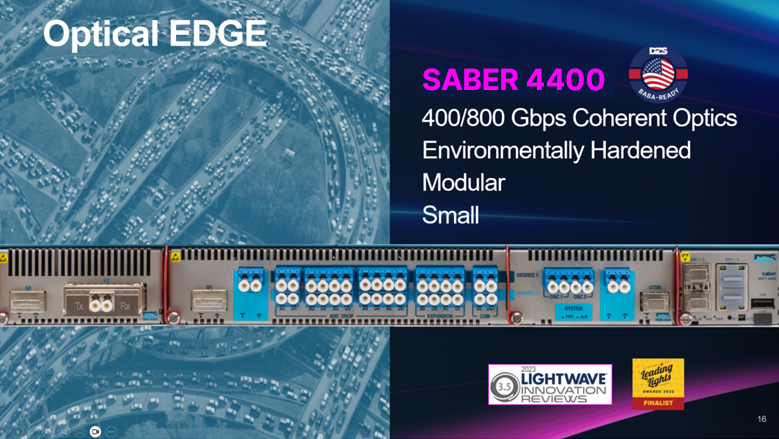It is safe to say that since the origins of Fiber Connect and the Fiber-to-the-Home Show before it, there was very little focus on the Middle-Mile. At Fiber Connect 2023, Middle-Mile moved from back-of-mind to front-and-center in both the strategic planning for fiber access networks going forward as well as in the Middle-Mile transport solutions that were on display in the exhibition hall. Why this rapid shift? I believe it comes down to a handful of primary drivers:
- The $1 billion Middle-Mile Grant program
- The capacity challenges posed by next-generation PON technologies
- Long-term BEAD strategies
Let’s explore these drivers a little more deeply.
The Middle-Mile Grant Program
The Middle-Mile Grant Program (MMGP) has now passed the grant award stage and is deep into vendor selection and deployment. By the U.S. federal government’s own admission, the MMGP was meant to be a trial run for the much larger $42.5B BEAD program. That said, when you throw $1B at any problem, it will gather a lot of attention. In the case of the MMGP, it gathered too much attention with award submissions greatly exceeding the amount of money available. In any event, many service providers and other entities sought to leverage MMGP funds to establish a foundation for future BEAD buildouts, and the awardees turned out in force at Fiber Connect 2023 to look for the right solutions to meet the requirements of their buildouts.
Those who were not selected for MMGP awards turned out too, as Middle-Mile solutions are ESSENTIAL to their long-term plans to bridge the digital divide in their markets. Why? Because most of the unserved and underserved areas targeted by BEAD are far away from existing facilities, meaning that if you build next-generation PON in those remote communities, you are going to have to figure out a way to both aggregate and transport the bandwidth to and from those communities. Making this challenge worse, with XGS-PON emerging as the dominant Last-Mile access technology, most existing transport rings will require a significant upgrade beyond the typical 1 Gbps and 10 Gbps transport rings that exist in most rural areas today. For many of these communities, the next natural bandwidth step for aggregating and transporting multiple PONs leaps to 100 Gbps – well beyond the capacity of existing deployed transport equipment and the capabilities of traditionally deployed transport technologies.
Capacity challenges posed by next-generation PON technologies
That brings us to key change number 2 – the capacity challenges posed by next-generation PON technologies. As mentioned above, even with concentration strategies applied to XGS-PON networks, as service providers begin to aggregate multiple PONs, they will rapidly exceed the 1-10 Gbps ring capacities that feed most rural areas. A leap to 100 Gbps is a safe bet … for now. But even then, the combination of distance and required capacity makes traditional transport technologies and solutions expensive. Add to this challenge the reality that upgrades to even more bandwidth intensive applications and emerging technologies like 50 Gbps PON will require 400 Gbps speeds, and its easy to see why service providers at Fiber Connect 2023 were searching for new transport technologies that could meet there emerging needs. The good news is that they found answers in new innovations from DZS at Fiber Connect 2023 that introduced the world’s first environmentally hardened transport solutions that leverage coherent optics to bring up to 400 Gbps per lambda over 100km WITHOUT amplification. This solution – the Saber 4400 Optical Edge platform – was a major draw at the show and expanded the thinking of a wide range of service providers in attendance.
Long-term BEAD strategies
Change number 3 stands firmly at the intersection of the two aforementioned changes. Service providers planning to leverage BEAD awards going forward will not be planning their networks with blinders on as to how these networks will ultimately complement their existing strategies. Savvy service providers will recognize that the same transport network that will be needed to span the long gaps to reach unserved and underserved remote locations will likely pass other network assets and deployment opportunities along the way. Thus, the subsidization of transport networks reaching communities in remote areas can also be leveraged in the future to support upgrades to many of their existing served communities as well as potentially create a foundation for new opportunities for future network expansion. Again – the robustness of the transport infrastructure becomes critical for opening these new opportunities, and service providers at Fiber Connect 2023 were seeking transport solutions that could efficiently and effectively meet not only their challenges in meeting their BEAD buildouts today, but could scale to meet new requirements and opportunities in the future.
DZS was thrilled with the response it received at Fiber Connect 2023 to its groundbreaking Saber 4400 platform that is perfectly suited to meet the challenges and opportunities of bridging the digital divide and providing a strategic springboard for the future. This 1 RU platform features hardened coherent optics, allowing for up to 4 DWDM lambdas at capacities ranging from 10 Gbps to 100 Gbps as well as 400 Gbps (for a total capacity of 1.6 Tbps per platform) to be deployed, and can scale to even the most robust future service demands. In addition, the Saber platforms can stack and continue to expand, as well has have the potential to increase individual capacities to a planned 800 Gbps per lambda in the future. The platform also offers a variety of complementary features including 2-degree CDC FlexGrid ROADM functionality (which can be expanded via stacking to 8-degrees) and the ability to reach over 100km of distance without amplification. It also features multiple enhancement options for amplification, hot-swappable management, SNMP and NETCONF/YANG configuration, and integration with DZS Xtreme for ease of service turn-up and management.
The Saber 4400 platform is already receiving rave reviews from customers and analysts, including awards from renowned industry publications Lightwave and Light Reading, for a number of reasons:
- It is environmentally hardened and as a result capable of being deployed at a fraction of the cost of traditional DWDM solutions designed for the data center (read this cost analysis from Palmetto Engineering where they state Saber can save up to $200,000 per site deployed).
- It is uniquely suited for BEAD and other government programs, being both “Buy America” compliant (It is produced in Santa Clara, California) and is made to be deployed in remote areas given its climate resiliency, extraordinary reach, and compact size.
- It is future-ready, with extraordinary capacity (1.6 Tbps per 1 RU today), scalability (modular and stackable yet able to be managed as a single virtual chassis), and capable of scaling to 800 Gbps per lambda in the future.
- It is strategic, capable of being deployed over long distances cost effectively and managed remotely for rapid ROI, while also scaling to meet the needs of future opportunities when called upon.
Yes – the Middle-Mile was a hot topic at Fiber Connect 2023 indeed, and DZS was ready, with the industry’s best overall optical edge solution optimized for the emerging transport and aggregation requirements driven by next-generation technologies and once-in-a-generation government subsidies. If you are interested in learning more, I encourage you to read a Heavy Reading white paper about these emerging requirements of the new optical edge, or contact us.
Moving on partially from the Middle-Mile, my next blog focuses on hot-off-the-presses information shared during Fiber Connect 2023 – what are the next-generation PON technologies that are driving new Middle-Mile requirements, and how should service providers position themselves to take advantage of them? Read Part 4: XGS-PON Has Momentum Today, But Next-Generation PON Technologies Are On the Horizon.



 '
'
